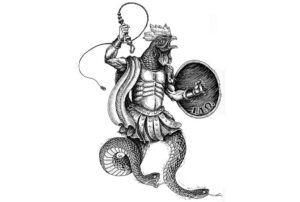Table of Contents
In Greek mythology, Eurydice embodies tragic love, emphasizing life’s unpredictability. Shortly after marrying Orpheus, she tragically succumbs, underscoring joy’s ephemeral nature.
Her descent into the Underworld serves as a metaphor for life’s journey, death’s inevitability, and relationship challenges. Eurydice, a nymph symbolizing innocence, tragically succumbs to a serpent, representing the intrusion of unforeseen dangers.
Eurydice’s story highlights Orpheus’s powerful music and deep love, showcasing their strength to overcome obstacles. Simultaneously, it warns about trust’s importance and the consequences of doubt.
Her death prompts profound grief in Orpheus, symbolizing human sorrow and the extraordinary lengths one goes to overcome loss.
The condition not to look back as Orpheus leads Eurydice symbolizes trust’s fragility, cautioning about doubt’s consequences and the challenges of maintaining faith.
In some interpretations, Eurydice’s transformation into a shade in the Underworld symbolizes the cycle of life, death, and rebirth, enriching the myth’s symbolism.
Transitioning to Eurydice’s role as a nymph, she lacks specific god-like powers. Nymphs, tied to natural elements, embody qualities related to their domains. Eurydice’s significance lies in her connection to nature, setting her apart from gods and goddesses.
While she lacks supernatural abilities, her tale with Orpheus highlights the extraordinary power of his enchanting music. Eurydice, though not possessing godly traits, plays a crucial role as Orpheus’s beloved, catalyzing his journey to the Underworld.
Family
Different sources and interpretations vary Eurydice’s parentage. Some accounts designate her as one of Apollo’s daughters, the god of music, arts, and prophecy. Other versions identify her as the daughter of the river god Peneus. The story of Eurydice’s engagement and love revolves around her relationship with Orpheus, the legendary musician and poet.
Eurydice’s Tragic Descent

The details may vary slightly depending on different versions of the myth, but a common narrative goes as follows:
Eurydice and Orpheus deeply loved each other, leading to their decision to marry. However, their joy was brief. On their wedding day, Aristaeus, a shepherd and satyr, pursued Eurydice in the meadows. Attempting to escape, she stepped on a venomous snake, resulting in her death.
Devastated, the exceptionally musically gifted Orpheus chose to descend into the Underworld. There, he pleaded with Hades, the god of the Underworld, to allow Eurydice to return to the world of the living. Orpheus’s captivating music moved not only the denizens of the Underworld but also the gods themselves.
Hades eventually agreed to let Eurydice go but on one condition: Orpheus must lead her out of the Underworld without looking back until they reached the surface. Unfortunately, just as they were about to emerge into the world of the living, Orpheus couldn’t resist the urge to look back, breaking the condition. As a result, Eurydice was lost to him forever, returning to the Underworld. This tragic tale is a poignant story of love, loss, and the consequences of defying the conditions set by the gods.
Symbology
In Greek mythology, Eurydice symbolizes tragic love and the fleeting nature of happiness within the myth of Orpheus and Eurydice. Her fate illustrates the ephemeral quality of joy, emphasizing life’s unpredictability, as she tragically succumbs shortly after marrying Orpheus.
Eurydice’s descent into the Underworld becomes a metaphor for life’s journey, death’s inevitability, and the challenges of reclaiming lost elements. This journey also symbolizes the hardships and obstacles encountered in relationships.
As a nymph, Eurydice embodies innocence and nature. Her tragic demise, bitten by a serpent, signifies lost innocence and unexpected dangers.
Eurydice’s story emphasizes Orpheus’s powerful music and deep love, revealing their ability to overcome obstacles but warning about trust’s importance and doubt’s consequences.
Her death deeply grieves Orpheus, symbolizing profound human sorrow and the extraordinary lengths one goes to overcome loss.
Orpheus’s condition not to look back as he leads Eurydice symbolizes trust’s fragility, cautioning about doubt’s consequences and the challenges of maintaining faith.
Eurydice’s transformation into a shade in the Underworld symbolizes the cycle of life, death, and rebirth in interpretations, enriching the myth’s symbolism.

FAQ
Is Eurydice a human?
In Greek mythology, Eurydice is typically portrayed as a nymph, a supernatural being associated with nature.
Who is Eurydice, and what does she do?
Eurydice is a nymph known for her association with nature and her tragic love story with Orpheus.
Was Eurydice a princess?
Eurydice is not commonly described as a princess in Greek mythology.
Is Eurydice a myth?
Eurydice is a figure in Greek mythology, representing the theme of love and loss.
Did Eurydice have kids?
In most versions of the myth, Eurydice and Orpheus do not have children.
Why is Eurydice so silent?
The idea that Eurydice is silent may be derived from the fact that her role in the myth is often overshadowed by Orpheus.
What becomes of Eurydice?
In the myth, Eurydice dies and remains in the Underworld after Orpheus looks back during their ascent.
Who loves Eurydice?
Orpheus loves Eurydice deeply, as depicted in the Greek myth.
Why was Eurydice in Hades?
Eurydice is in Hades, the Underworld, because she died and was taken there after being bitten by a snake.
Why did Eurydice go to Hades?
Eurydice went to Hades after her death, a common fate in Greek mythology.
What gender is Orpheus?
Orpheus is male, a legendary musician and poet in Greek mythology.
Why did Orpheus look back at Eurydice?
In the myth, Orpheus looks back at Eurydice out of doubt or a momentary lapse in faith, breaking the condition set by Hades.
Why did Orpheus save Eurydice?
Orpheus attempted to save Eurydice by using his musical talents to plead with Hades for her release from the Underworld.
How to reunite Orpheus and Eurydice?
In Greek mythology, Orpheus attempted to reunite with his wife Eurydice by descending into the Underworld to retrieve her. His musical talents were so extraordinary that they moved Hades, the god of the Underworld. Hades allowed Orpheus to take Eurydice back to the world of the living on one condition: Orpheus must not look back at Eurydice until they had both reached the surface. Unfortunately, Orpheus couldn't resist and glanced back, breaking the condition and losing Eurydice forever.
Who is Eurydice in Antigone
Eurydice is not a character in Sophocles' play "Antigone." The main characters in "Antigone" include Antigone, Creon, Ismene, Haemon, and others. Eurydice is more commonly associated with the myth of Orpheus and Eurydice.
How to pronounce Eurydice
"Eurydice" is pronounced yoo-RID-uh-see.
How did Eurydice die?
In Greek mythology, Eurydice died when she stepped on a snake while trying to escape from a pursuer. She was bitten and succumbed to the venom, leading to her descent into the Underworld.
Who is Eurydice?
In Greek mythology, Eurydice is an oak nymph and the wife of Orpheus, a legendary musician and poet. Her story is best known through the myth of Orpheus and Eurydice, where Orpheus tries to rescue her from the Underworld.
Which of the following excerpts from Orpheus and Eurydice is an example of hyperbole?
Without specific excerpts provided, it's challenging to identify the hyperbole. Hyperbole involves exaggeration for emphasis, so you would need a particular line or phrase to analyze.
Who wrote Orpheus and Eurydice?
The story of Orpheus and Eurydice is a part of Greek mythology, and it doesn't have a single identifiable author. Various versions of the myth appear in different works, including poems by Ovid and in references in other classical literature. Ovid's "Metamorphoses" is one of the well-known sources that recounts the tragic tale of Orpheus and Eurydice.




